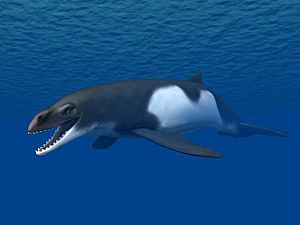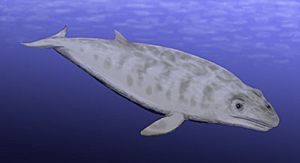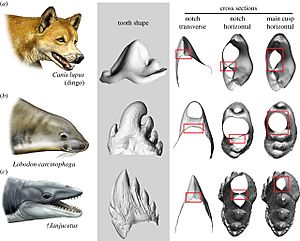Janjucetus facts for kids
Quick facts for kids Janjucetus |
|
|---|---|
 |
|
| Skull of Janjucetus hunderi at the Melbourne Museum | |
| Scientific classification | |
| Genus: |
Janjucetus
|
| Species: |
hunderi
|
Janjucetus was an ancient whale that lived about 25 million years ago. It's now extinct, meaning it no longer exists. This special whale lived off the coast of what is now southeastern Australia. Unlike modern baleen whales, Janjucetus had large teeth instead of baleen plates. It likely used these teeth to catch and eat big prey like fish. Scientists believe it hunted in a way similar to today's leopard seals.
Contents
Discovering Janjucetus
The only known fossil of Janjucetus was found in Australia in the late 1990s. A teenage surfer named Staumn Hunder discovered it near the town of Jan Juc in Victoria. He saw brown fossils on a large rock while surfing. The rock contained marine sediment from about 27 to 23.9 million years ago.
Soon after, Staumn and his father moved the rock to Monash University for study. The fossil is very well-preserved. It includes a nearly complete skull, jawbones, and parts of its spine and ribs. This important fossil is now kept at the Museums Victoria Palaeontology Collection in Melbourne.
In 2006, a scientist named Erich Fitzgerald officially described the species. He named it Janjucetus hunderi to honor both the town of Jan Juc and its discoverer, Staumn Hunder. This fossil is the most complete ancient whale fossil ever found in Australia from the Paleogene period. Other ancient whale fossils, like Mammalodon, Prosqualodon, and Waipatia, have also been found near Jan Juc Beach.
What Janjucetus Looked Like
Scientists believe Janjucetus was about 3.5 meters (11.5 feet) long. This is about the same size as a modern bottlenose dolphin. It was much smaller than the huge baleen whales we see today. Its snout, or nose area, was wide and shaped like a triangle. It wasn't flat or long like the snouts of modern baleen whales.
The two halves of its lower jaw were joined together. Modern baleen whales have flexible jaws that can open very wide. Janjucetus did not have this flexibility.
Unlike many modern whales, Janjucetus could not echolocate. Echolocation is like using sound to "see" in the water. However, it had unusually large eyes for a whale of its kind. These eyes were placed high on its skull. This suggests that Janjucetus probably relied on its excellent eyesight to find its way and hunt. It might have also had a line of fat along its lower jaw, similar to modern toothed whales. This would have helped it detect ultrasonic signals, which are sounds too high for humans to hear.
Janjucetus did not have baleen plates. Instead, it had large, strong teeth. Its front teeth (incisors and canines) were pointed, good for stabbing prey. Its back teeth (premolars and molars) were shaped like serrated blades. These teeth were deeply rooted, meaning they were held firmly in its jaw. This was likely an adaptation for catching and holding large, struggling prey.
It had strong jaw muscles, which meant it had a powerful bite. The teeth had heavily ridged enamel, which is the hard outer layer. The upper teeth were spaced wider apart than the lower teeth. These unique teeth show how specialized Janjucetus was for its particular way of life.
How Janjucetus Fits in the Whale Family Tree
| Janjucetus within Mysticeti | |||||||||||||||||||||||||||||||||
|
|||||||||||||||||||||||||||||||||
| Family tree showing Janjucetus at the base of Mysticeti (baleen whales) |
Even though Janjucetus didn't have baleen, scientists consider it a type of baleen whale (Mysticeti). This is because its skull has certain features that are unique to baleen whales. For example, the way its nasal bones connect to its braincase is a key clue.
Janjucetus belongs to a group called Mammalodontidae. The only other known whale in this group is the extinct Mammalodon, which also lived in southeastern Australia. At first, Janjucetus was placed in its own family. But later studies showed it was closely related to Mammalodon.
Janjucetus is one of six known ancient baleen whales from the Oligocene period that still had teeth. The others include M. colliveri, M. hakataramea, Chonecetus, Aetiocetus, and Llanocetus.
What Janjucetus Ate
Unlike modern baleen whales that filter tiny organisms from the water, Janjucetus used its teeth to catch larger prey. It likely ate big fish and even sharks. Its skull looks similar to that of the modern leopard seal. This suggests that Janjucetus might have used a similar hunting method. Leopard seals often grip their prey and then tear it apart.
However, it's also possible that Janjucetus's front teeth interlocked. Its cheek teeth might have sheared against each other when its mouth was closed. This could have allowed it to do some filter feeding, similar to the modern crabeater seal. Crabeater seals have special teeth that help them strain krill from the water. This type of feeding might have been an early step towards the evolution of baleen in later whales. The head of Janjucetus was also wide and blunt, like some modern toothed whales that use suction to feed. This means it might have been able to suck in its prey.




